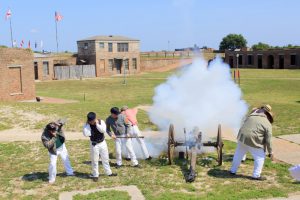 History buffs know all about the rich history and culture along Alabama’s Coastal Connection, but it might not be so obvious to those passing through. Along the byway, there are plenty of spots to stop and learn a little about the past. If the Civil War era is of particular interest to you, then you’ve come to the right place. Below, we discuss our favorite beach byway stops to learn about Alabama’s role in the Civil War.
History buffs know all about the rich history and culture along Alabama’s Coastal Connection, but it might not be so obvious to those passing through. Along the byway, there are plenty of spots to stop and learn a little about the past. If the Civil War era is of particular interest to you, then you’ve come to the right place. Below, we discuss our favorite beach byway stops to learn about Alabama’s role in the Civil War.
First stop: Fort Gaines. This masonry fort located on Dauphin Island dates back to 1821 and played an important role in the Battle of Mobile Bay during the Civil War. Guides dressed in period uniform offer tours as well as cannon firing and blacksmithing demonstrations. It’s a fun and educational stop for adults and kids alike.
 Next stop is Fort Morgan, which you can get to from Fort Gaines via the Mobile Bay Ferry. During the Civil War, Union and Confederate ships battled fiercely for control of the waters of Mobile Bay. At Fort Morgan, enjoy a tour or historical reenactments that tell the tale of this historic masonry star fort built to protect the mouth of Mobile Bay in 1819. When the Civil War broke out, the fort was seized by Alabama troops for the Confederacy and provided protection for blockade runners entering Mobile Bay.
Next stop is Fort Morgan, which you can get to from Fort Gaines via the Mobile Bay Ferry. During the Civil War, Union and Confederate ships battled fiercely for control of the waters of Mobile Bay. At Fort Morgan, enjoy a tour or historical reenactments that tell the tale of this historic masonry star fort built to protect the mouth of Mobile Bay in 1819. When the Civil War broke out, the fort was seized by Alabama troops for the Confederacy and provided protection for blockade runners entering Mobile Bay.
An hour and a half north of Fort Morgan lies Fish River. Near the river sits an environmental education center and a public boat launch, but during the Civil War, troops gathered here after journeying from Fort Gaines on army transports and naval gunboats and sailed up Fish River on their way to Spanish Fort.
A visit to May Day Park in Daphne, also known as Starke’s Landing, is also a worthy stop along your history tour. This site served as a U.S. Army supply depot during the Civil War. From here, a flotilla crossed the bay in the move to occupy Mobile.
 In nearby Spanish Fort, visit the Eastern Shore Welcome Center to learn about the part Fort McDermott and the 8th Iowa Line played in the siege and battle at Spanish Fort. Near the end of the way, the Union army attacked this fortification for 13 days straight. The Union troops vastly outnumbered the Confederates, and when the Union troops finally stormed they found the fort empty. The Confederates had fled, and the Civil War ended that very day when General Lee surrendered at the Appomattox Court House.
In nearby Spanish Fort, visit the Eastern Shore Welcome Center to learn about the part Fort McDermott and the 8th Iowa Line played in the siege and battle at Spanish Fort. Near the end of the way, the Union army attacked this fortification for 13 days straight. The Union troops vastly outnumbered the Confederates, and when the Union troops finally stormed they found the fort empty. The Confederates had fled, and the Civil War ended that very day when General Lee surrendered at the Appomattox Court House.
From there make your way over to Blakeley State Park, where 26,000 soldiers fought the last significant battle of the Civil War after Lee had surrendered.
For an unparalleled, first-hand history lesson, there’s no better bet than a tour along the Alabama Coastal connection, where the past lives on. Where will your first stop take you?



Leave A Comment